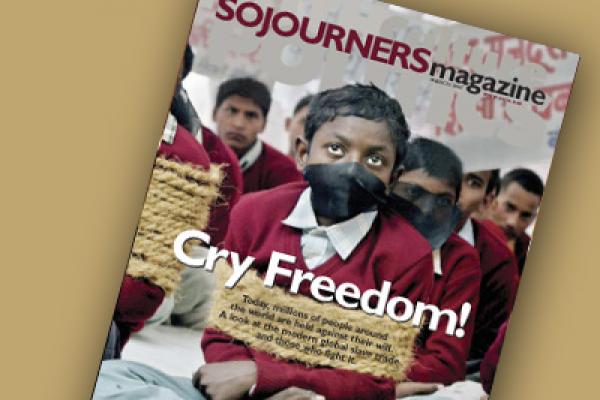In 1994, Pierre Tami established the Hagar Shelter in Phnom Penh, Cambodia, as a haven for women who had fallen victim to violence and sexual exploitation. Hagar has assisted more than 100,000 women and children through its social programs and economic projects. The U.S. State Department in 2004 selected Tami and the Hagar project as one of its six international heroes in the struggle against the global slave trade. The story of how Pierre Tami created one of the most innovative programs for freed slaves will inspire even the most entrenched cynics.
Tami, a Swiss businessman, had devoted 12 years to helping people in crisis—including a long stint in Japan aiding the homeless in the parks of downtown Osaka and several years more building up a youth drop-in center in Singapore. He could not explain why, but he understood these ventures as a training ground for some greater project. He received the invitation to visit Cambodia in June 1990.
A civil war threatened to throw the country into chaos. Though the ruling regime was paranoid about the presence of foreigners, it asked Tami to evaluate the potential of providing aid to its impoverished masses. Only 25 nongovernmental aid agencies were operating in Cambodia at the time.
When Tami first arrived in one village, silence blanketed the town—except for a single, terrible wail. A mother had just lost her 6-month-old baby, a casualty of malaria. She spilled out her agony and protest.
A traditional Cambodian (Khmer) proverb muses, "If Heaven could cry, then Cambodia would never know drought." For Tami, the mother's wail became the cry of a people, and it haunted him long after he had left the country.
Two weeks after that trip, Tami fell gravely ill with a rare strain of malaria that travels directly to the brain. Doctors gave him only a 50 percent chance of survival. He spent several weeks in the hospital. While recuperating, Tami regularly read his Bible—his faith in God served as an anchor in his life. The near-death experience increased his sense of urgency about the future. His daily prayer: "I was born for a purpose. Show me what that purpose might be."
One morning a passage in 2 Corinthians seemed to speak directly to him: God helps us in all our troubles, so that we are able to help others who have all kinds of troubles, using the same help that we ourselves have received from God.
Images of the Cambodian people he had just visited crystallized in Tami's mind. He had received a dramatic healing. Now it was his turn to bring comfort to Cambodian women and children who suffered from poverty and violence.
TAMI PAID SEVERAL more visits to Cambodia in 1991 and 1992. The political scene inside the country continued to be tense. While he watched and waited, Tami began learning the Khmer language. It was a trusted method that went back to his childhood in the south of Switzerland, when a Catholic priest who was serving the poor in Africa visited Tami's church and shared the story of St. Francis of Assisi. The young Tami heard a voice inside him say, "I want to be like St. Francis." Tami asked the priest, "What can I do in order to devote myself to serving the poor?" The priest replied, "Son, develop a unique skill and learn languages, and God will use you."
But Tami admits that somewhere in adolescence he lost the plot. At 20, he began a fast track to business management and lived the high life of travel and opulence. But at 23, he recalled the story of St. Francis. He decided material gain could never bring him fulfillment. He was seriously dating a woman, Simonetta, who shared his sense of spiritual purpose. After a year of study and spiritual reflection, the couple married and moved to Japan.
Cambodia represented another leap of faith. In early 1993 Tami, Simonetta, and their three young daughters moved to Phnom Penh. Tami surveyed the needs of women living on the streets. An alarming number of husbands had kicked their wives out after finding a younger woman as a replacement. Nearly all of the women had suffered physical abuse from their husbands. Many women had been trafficked to Phnom Penh for sexual exploitation.
The survey pointed to a dire need for a shelter for homeless mothers and their children. Other agencies in Cambodia reached out to street kids or single women, but steered clear of mothers. "It's a very costly endeavor," the director of one international aid group warned Tami. "Not only do children come along as part of the package, but who takes care of them if the mother finds a job?"
Complicated challenges do not easily discourage Tami. Despite being a remarkable visionary, he avoids making wild promises that he does not intend to keep. Execution is secondary in his mind; discovering the right mission is paramount.
Once again, the Bible provided direction. He bumped into the story of Hagar, an Egyptian servant in the house of Abraham. Hagar conceived a child with Abraham. But spurred on by the jealousy of his wife, Sarah, Abraham cast Hagar out into the desert with her son, Ishmael. As they were about to die of starvation, Ishmael shrieked in pain. God heard his cry, saved mother and son, and blessed their future.
Hagar literally means "the one who flees and is afraid." Tami considered it the perfect name for his new shelter.
WITHIN ABOLITIONIST circles, Hagar would be called an "aftercare facility." At Hagar, the term reintegration is used, reflecting its goal to equip women to return to society as independent, productive citizens. In most cases, the women need post-traumatic counseling to help them overcome past abuses. Few can read or write or possess a vocational skill, so Hagar provides an expansive education program.
There was an extreme scarcity of jobs in the Cambodian job market. The best way to ensure employment for the women, Tami realized, would be to create real jobs. And he dreamed of creating a range of Hagar enterprises that could underwrite a healthy slice of the agency's social services budget.
Hagar's Soya Company is Cambodia's first and only large-scale producer of soya milk. It began humbly in 1998 when 25 women staying at the shelter were daily sent out to the streets with wooden carts full of fresh soya milk; they sold small plastic bags of the milk for 20 cents.
A few years later, the U.S. Department of Agriculture contacted Tami about creating a milk nutrition program in Cambodia's public schools. At first Tami had to laugh at the notion of women filling thousands of plastic bags of milk every day for schoolchildren. But the USDA linked Hagar up with the International Finance Corporation (IFC), which supports enterprise development around the globe.
With IFC financing, Hagar Soya made the leap from a tiny microenterprise with a production capacity of 500 liters per day to a significant factory capable of producing 12,000 liters per day in packaging that allows distribution throughout Cambodia. By mid-2006, Hagar Soya's payroll included 83 employees.
Tami's second enterprise, Hagar Catering, grew out of a cooking-skills program offered at the shelter. Hagar Catering today provides quality meals in staff canteens at major hotels, factories, and government agencies in Phnom Penh. Clients include the U.S. Embassy, five-star hotels such as the InterContinental and Raffles Hotel Le Royal, and international companies such as British American Tobacco. In 2005 Hagar Catering delivered a dividend of $20,000 cash toward funding Hagar's social service projects.
Tami's third enterprise, Hagar Design Limited, was established in 2004 to manufacture women's accessories and home decor products. Still in its infancy, the company currently employs 85 workers and has healthy revenue growth.
Given his sterling record in Cambodia, the IFC and other international investors have encouraged Tami to implement the Hagar model in other sites where the slave trade has left a trail of victims. He is investigating new projects in Africa, Latin America, and other parts of Asia—and waiting for a moment of revelation. After all, execution is secondary in his mind. Discovering the right mission is paramount.
David Batstone is a Sojourners contributing editor. This article is adapted from his new book Not For Sale: The Return of the Global Slave Trade—and How We Can Fight It (HarperSanFrancisco, © 2007).
Join the New Abolitionist Movement
Organizations working to combat domestic or international slavery, trafficking, and debt bondage include:
• Hagar Project: www.hagarproject.org
• American Anti-Slavery Group: www.iabolish.com
• Anti-Slavery: www.antislavery.org
• Coalition to Abolish Slavery and Trafficking: www.castla.org
• Free the Slaves: www.freetheslaves.net
• International Justice Mission: www.ijm.org
• Not For Sale: www.notforsalefund.org
• The Polaris Project: www.polarisproject.org
• Protection Project: www.protectionproject.org
• Shared Hope International: www.sharedhope.org
• Vital Voices: www.vitalvoices.org

Got something to say about what you're reading? We value your feedback!
